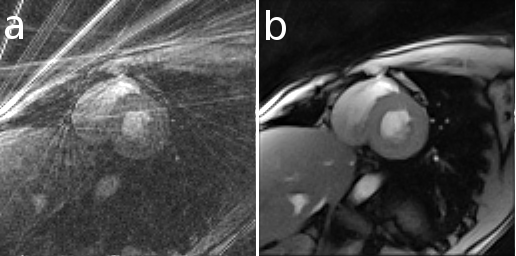Iterative reconstruction

Iterative reconstruction refers to iterative algorithms used to reconstruct 2D and 3D images in certain imaging techniques. For example, in computed tomography an image must be reconstructed from projections of an object. Here, iterative reconstruction techniques are a better, but computationally more expensive, alternative to the common filtered back projection (FBP) method, which directly calculates the image in a single reconstruction step.[1]
Basic concepts
The reconstruction of an image from the acquired data is an inverse problem. Often, it is not possible to exactly solve the inverse problem directly. In this case, a direct algorithm has to approximate the solution, which might cause visible reconstruction artifacts in the image. Iterative algorithms approach the correct solution using multiple iteration steps, which allows to obtain a better reconstruction at the cost of a higher computation time.
In computed tomography, this approach was the one first used by Hounsfield. There are a large variety of algorithms, but each starts with an assumed image, computes projections from the image, compares the original projection data and updates the image based upon the difference between the calculated and the actual projections.
There are typically five components to iterative image reconstruction algorithms, e.g. .[2]
- An object model that expresses the unknown continuous-space function
 that is to be reconstructed in terms of a finite series with unknown coefficients that must be estimated from the data.
that is to be reconstructed in terms of a finite series with unknown coefficients that must be estimated from the data. - A system model that relates the unknown object to the "ideal" measurements that would be recorded in the absence of measurement noise. Often this is a linear model of the form
 , where
, where  represents the noise.
represents the noise. - A statistical model that describes how the noisy measurements vary around their ideal values. Often Gaussian noise or Poisson statistics are assumed. Because Poisson statistics are closer to reality, it is more widely used.
- A cost function that is to be minimized to estimate the image coefficient vector. Often this cost function includes some form of regularization. Sometimes the regularization is based on Markov random fields.
- An algorithm, usually iterative, for minimizing the cost function, including some initial estimate of the image and some stopping criterion for terminating the iterations.
Advantages
The advantages of the iterative approach include improved insensitivity to noise and capability of reconstructing an optimal image in the case of incomplete data. The method has been applied in emission tomography modalities like SPECT and PET, where there is significant attenuation along ray paths and noise statistics are relatively poor.
As another example, it is considered superior when one does not have a large set of projections available, when the projections are not distributed uniformly in angle, or when the projections are sparse or missing at certain orientations. These scenarios may occur in intraoperative CT, in cardiac CT, or when metal artifacts [3] require the exclusion of some portions of the projection data.
In Magnetic Resonance Imaging it can be used to reconstruct images from data acquired with multiple receive coils and with sampling patterns different from the conventional Cartesian grid[4] and allows the use of improved regularization techniques (e.g. total variation)[5] or an extended modeling of physical processes[6] to improve the reconstruction. For example, with iterative algorithms it is possible to reconstruct images from data acquired in a very short time as required for Real-time MRI.[7]
Here is an example that illustrates the benefits of iterative image reconstruction for cardiac MRI.[8]

See also
- Tomographic reconstruction
- Tomogram
- Computed Tomography
- Magnetic Resonance Imaging
- Inverse problem
- Osem
- Deconvolution
References
- ↑ Herman, G. T., Fundamentals of computerized tomography: Image reconstruction from projection, 2nd edition, Springer, 2009
- ↑ J A Fessler, "Penalized weighted least-squares image reconstruction for positron emission tomography," IEEE Trans. on Medical Imaging, 13(2):290-300, June 1994.
- ↑ FE Boas and D Fleischmann. "Evaluation of two iterative techniques for reducing metal artifacts in computed tomography." Radiology, doi:10.1148/radiol.11101782, 2011.
- ↑ Pruessmann, K. P., Weiger, M., Börnert, P. and Boesiger, P. (2001), Advances in sensitivity encoding with arbitrary k-space trajectories. Magnetic Resonance in Medicine, 46: 638–651. doi:10.1002/mrm.1241
- ↑ Block, K. T., Uecker, M. and Frahm, J. (2007), Undersampled radial MRI with multiple coils. Iterative image reconstruction using a total variation constraint. Magnetic Resonance in Medicine, 57: 1086–1098. doi:10.1002/mrm.21236
- ↑ Fessler, J. (2010) Model-based Image Reconstruction for MRI. Signal Processing Magazine, IEEE 27:81-89
- ↑ 7.0 7.1 M Uecker, S Zhang, D Voit, A Karaus, KD Merboldt, J Frahm (2010a) Real-time MRI at a resolution of 20 ms. NMR Biomed 23: 986-994, doi:10.1002/nbm.1585
- ↑ I Uyanik, P Lindner, D Shah, N Tsekos I Pavlidis (2013) Applying a Level Set Method for Resolving Physiologic Motions in Free-Breathing and Non-gated Cardiac MRI. FIMH, 2013,
| Wikimedia Commons has media related to Iterative reconstruction. |
- ↑ Bruyant, P.P. "Analytic and iterative reconstruction algorithms in SPECT" Journal Of Nuclear Medicine 43(10):1343-1358, 2002